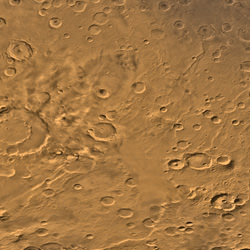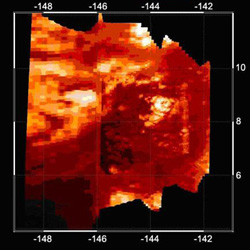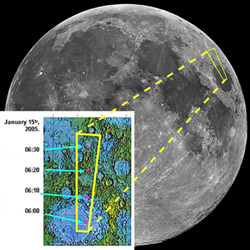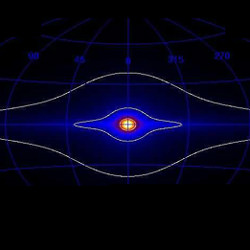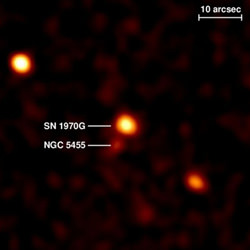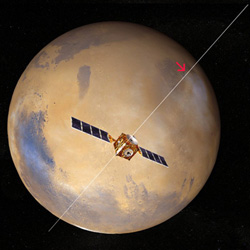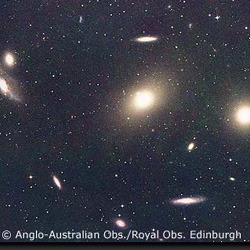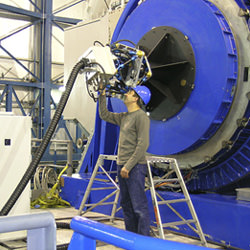
ULTRACAM instrument mounted on the Very Large Telescope. Image credit: ESO. Click to enlarge.
British scientists have opened a new window on the Universe with the recent commissioning of the Visitor Instrument ULTRACAM on the European Southern Observatory’s (ESO) Very Large Telescope (VLT) in Chile.
ULTRACAM is an ultra fast camera capable of capturing some of the most rapid astronomical events. It can take up to 500 pictures a second in three different colours simultaneously. It has been designed and built by scientists from the Universities of Sheffield and Warwick (United Kingdom), in collaboration with the UK Astronomy Technology Centre in Edinburgh.
ULTRACAM employs the latest in charged coupled device (CCD) detector technology in order to take, store and analyse data at the required sensitivities and speeds. CCD detectors can be found in digital cameras and camcorders, but the devices used in ULTRACAM are special because they are larger, faster and most importantly, much more sensitive to light than the detectors used in today’s consumer electronics products.
In May 2002, the instrument saw “first light” on the 4.2-m William Herschel Telescope (WHT) on La Palma. Since then the instrument has been awarded a total of 75 nights of time on the WHT to study any object in the Universe which eclipses, transits, occults, flickers, flares, pulsates, oscillates, outbursts or explodes.
These observations have produced a bonanza of new and exciting results, leading to already 11 scientific publications published or in press.
To study the very faintest stars at the very highest speeds, however, it is necessary to use the largest telescopes. Thus, work began 2 years ago preparing ULTRACAM for use on the VLT.
“Astronomers using the VLT now have an instrument specifically designed for the study of high-speed phenomena”, said Vik Dhillon, from the University of Sheffield (UK) and the ULTRACAM project scientist. “Using ULTRACAM in conjunction with the current generation of large telescopes makes it now possible to study high-speed celestial phenomena such as eclipses, oscillations and occultations in stars which are millions of times too faint to see with the unaided eye.”
Observing Black Holes
The instrument saw first light on the VLT on May 4, 2005, and was then used for 17 consecutive nights on the telescope to study extrasolar planets, black-hole binary systems, pulsars, white dwarfs, asteroseismology, cataclysmic variables, brown dwarfs, gamma-ray bursts, active-galactic nuclei and Kuiper-belt objects.
One of the faint objects studied with ULTRACAM on the VLT is GU Muscae. This object consists of a black hole in a 10-hour orbit with a normal, solar-like star. The black hole is surrounded by a disc of material transferred from the normal star. As this material falls onto the black hole, energy is released, producing large-amplitude flares visible in the light curve. This object has magnitude 21.4, that is, it is one million times fainter than what can be seen with the unaided eye. Yet, to study it in detail and detect the shortest possible pulses, it is necessary to use exposure times as short as 5 seconds. This is possible with the large aperture and great efficiency of the VLT.
These unique observations have revealed a series of sharp spikes, separated by approximately 7 minutes. Such a stable signal must be tied to a relatively stable structure in the disc of matter surrounding the black hole. The astronomers are now in the process of analysing these results in great details in order to understand the origin of this structure.
Another series of observations were dedicated to the study of extrasolar planets, more particularly those that transit in front of their host star. ULTRACAM observations have allowed the astronomers to obtain simultaneous light curves, in several colour-bands, of four known transiting exoplanets discovered by the OGLE survey, and this with a precision of a tenth of a percent and with a 4 second time resolution. This is a factor ten better than previous measurements and will provide very accurate masses and radii for these so-called “hot-Jupiters”. Because ULTRACAM makes observations in three different wavebands, such observations will also allow astronomers to establish whether the radius of the exoplanet is different at different wavelengths. This could provide crucial information on the possible exoplanets’ atmosphere.
The camera is the first instrument to make use of the Visitor Focus on Melipal (UT3), and the first UK-built instrument to be mounted at the VLT. The Visitor Focus allows innovative technologies and instrumentation to be added to the telescope for short periods of time, permitting studies to take place that are not available with the current suite of instruments.
“These few nights with ULTRACAM on the VLT have demonstrated the unique discoveries that can be made by combining an innovative technology with one of the best astronomical facilities in the world,” said Tom Marsh of the University of Warwick and member of the team. “We hope that ULTRACAM will now become a regular visitor at the VLT, giving European astronomers access to a unique new tool with which to study the Universe.”
More information
The ULTRACAM team is composed of Vik Dhillon, Stuart Littlefair, and Paul Kerry (Sheffield, UK), Tom Marsh (Warwick, UK), Andy Vick and Dave Atkinson (UKATC, Edinburgh, UK). For the installation on the VLT, they received support from Kieran O’Brien and Pascal Robert (ESO, Chile). The ULTRACAM project page can be found at http://www.shef.ac.uk/~phys/people/vdhillon/ultracam.
Original Source: ESO News Release

